
Helianthus is a genus comprising about 70 species of annual and perennial flowering plants in the daisy family Asteraceae commonly known as sunflowers. Except for three South American species, the species of Helianthus are native to North America and Central America. The best-known species is the common sunflower. This and other species, notably Jerusalem artichoke, are cultivated in temperate regions and some tropical regions, as food crops for humans, cattle, and poultry, and as ornamental plants. The species H. annuus typically grows during the summer and into early fall, with the peak growth season being mid-summer.

Grindelia (gumweed) is a genus of plants native to the Americas belonging to the family Asteraceae. The genus was named for Latvian botanist David Hieronymus Grindel, 1776–1836.

Chrysothamnus, known as rabbitbrush, rabbitbush, and chamisa, are a genus of shrubs in the family Asteraceae. The native distribution is in the arid western United States, Canada, and northern Mexico. It is known for its bright white or yellow flowers in late summer.
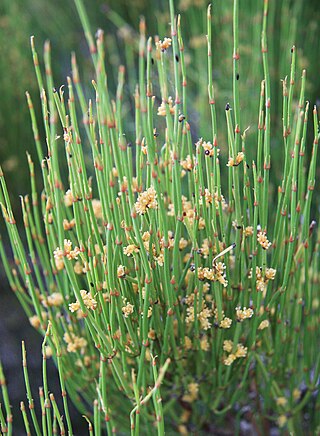
Ephedra is a genus of gymnosperm shrubs. The various species of Ephedra are widespread in many arid regions of the world, ranging across southwestern North America, southern Europe, northern Africa, southwest and central Asia, northern China and western South America. It is the only extant genus in its family, Ephedraceae, and order, Ephedrales, and one of the three living members of the division Gnetophyta alongside Gnetum and Welwitschia.

Hymenoxys is a genus of plants in the sunflower family, native to North and South America. It was named by Alexandre Henri Gabriel de Cassini in 1828.

Heterotheca is a genus of North American plants in the family Asteraceae.
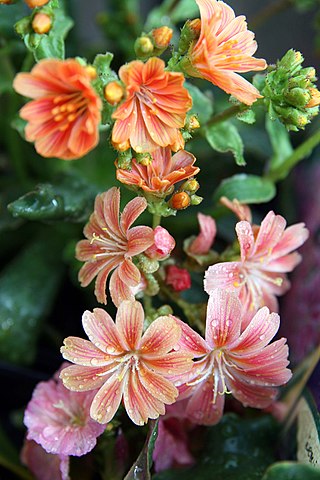
Lewisia is a plant genus, named for the American explorer Meriwether Lewis (1774-1809) who encountered the species in 1806. The native habitat of Lewisia species is rocky ground and cliffs in western North America. Native Americans ate the roots, which have also been used to treat sore throats.

Ericameria nauseosa, commonly known as chamisa, rubber rabbitbrush, and gray rabbitbrush, is a shrub in the sunflower family (Aster) found in the arid regions of western North America.
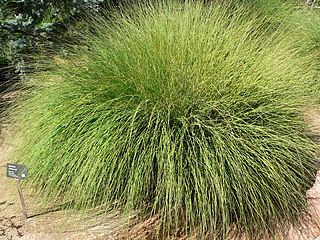
Muhlenbergia is a genus of plants in the grass family.

Balsamorhiza is a genus of plants in the family Asteraceae known commonly as balsamroots. These are perennials with fleshy taproots and caudices bearing erect stems and large, basal leaves. Atop the tall stems are showy yellow sunflower-like blooms. Balsamroots are native to western North America.
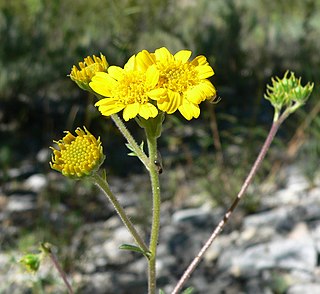
Hymenothrix is a small genus of North American flowering plants in the daisy family known as thimbleheads. They are native to the southwestern United States and northern Mexico.
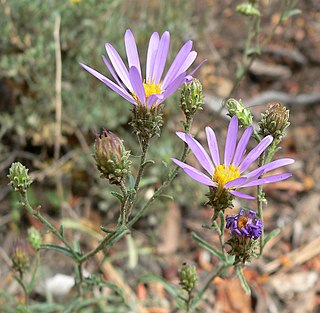
Dieteria is a North American genus of flowering plants in the family Asteraceae.

Lorandersonia, commonly called rabbitbush, is a genus of North American flowering plants in the family Asteraceae.

Hilaria is a genus of North American plants in the grass family. Members of the genus are commonly known as curly mesquite. They are found in the Southwestern United States, Mexico, and Guatemala.
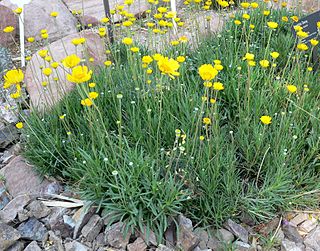
Tetraneuris, commonly known as four-nerve daisy or bitterweed, is a genus of North American plants in the sneezeweed tribe within the daisy family.
Eurybia horrida is a species of flowering plant in the family Asteraceae known by the common names spiny aster and horrid herrickia. It is native to Colorado and New Mexico in the United States, where it occurs only in the Canadian River basin. It most often included in genus Eurybia.

Scabrethia is a monotypic genus of North American flowering plants in the family Asteraceae.

Eurybia glauca is a North American species of flowering plants in the family Asteraceae, called the gray aster. It is native to the western United States, primarily in Arizona, New Mexico, Utah, Colorado, and Wyoming, with a few populations in Idaho and Montana.

Eurybia kingii is a North American species of flowering plants in the family Asteraceae, called the King's serpentweed or King's aster. It has been found only in the State of Utah in the western United States.

Mertensia lanceolata, known as prairie bluebells, lance-leaved bluebells, lance-leaved lungwort, and narrow-leaved languid ladies is a species of flowering plant native to the Rocky Mountains and areas of the northern Great Plains in western North America. A herbaceous perennial it has blue-green leaves alternately arranged on its smooth flowering stalk. Its flower buds are pink-purple and become blue as they open.



















